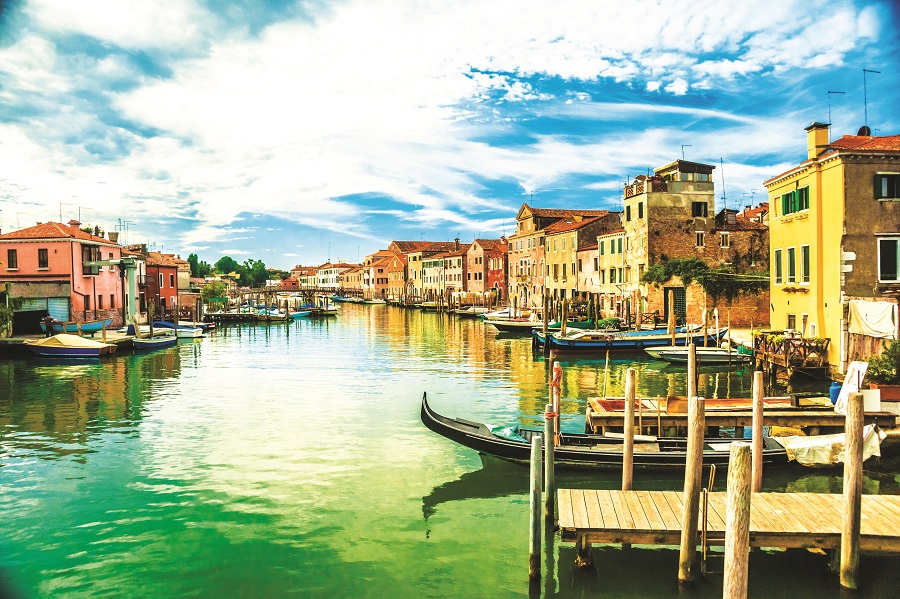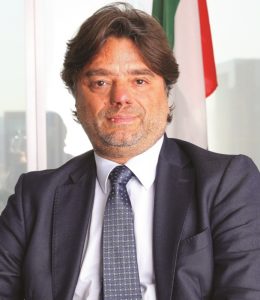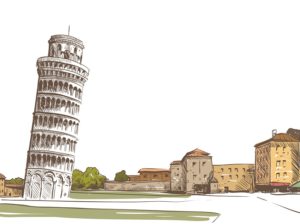Dubbed as an ‘open air’ museum, Italy features a unique landscape that offers rich historical buildings and modern pioneering developments. This rare marriage, many Italians say, has subsequently apparently shaped the HVAC industry, moulding it to provide creative and one-of-a-kind solutions, and has cultivated a more cohesive dynamic between HVAC businesses and architects and between designers and construction developers. In light of the challenging economic situation, HVAC companies are now leveraging the ‘Made in Italy’ brand and ethos to reinforce their position in the international market, including in the Middle East. A Climate Control Middle East exclusive report…

A mood of vigilant optimism is prevalent among Italian HVAC companies as they slowly emerge from the dark economic turmoil engendered by the protracted recovery from the Great Recession. In the face of economic challenges, HVAC companies remain eager to pursue new avenues of growth and further develop the ‘Made in Italy” brand in order to successfully penetrate international markets.
Gianpaolo Bruno, Italian Trade Commissioner to the UAE, Oman and Pakistan, shares his insights on the current state of the HVAC sector in Italy, particularly on the field of ventilation: “The trends are moderately positive at the moment, particularly on the export side, because the internal market is still in a phase of recovery from the general building and construction difficulties experienced in the last few years. There’s a lot of demand in the internal market for renovation but equally not so much for new buildings, private and commercial, but the export market is growing at a healthy pace.”
This emphasis on export is echoed by several home-grown companies. One such company is HW Ventilation, headquartered near Milan. Specialising in axial impellers and ventilators for industrial applications, the company noted that 70% of its revenue comes from worldwide export.¹

Gianpaolo Bruno
Given Bruno’s honest assessment of the nation’s current state he remains optimistic in light of the ongoing reforms and the active efforts of the public and private sector to drive growth in the economy, in general and the HVAC sector, in particular. “The country is recovering from a period of difficult conditions at the macroeconomic level,” he says. “It is coming out from [the conditions] at a good pace. It has good potential to even grow more in the future. A lot of structural reforms have been implemented, particularly in the labour market, in the fiscal system and in the banking system. We think that with these reforms in place, the country will be able to perform even better in the near future, so we are looking forward to it and the companies are getting ready for the new phase of economic development.”
EXPLORING NEW FRONTIERS
With such dynamic changes on the horizon, a number of factors are leading HVAC companies to new directions. The most significant of which are the new F-gas regulations, implemented by the European Union and the increasing emphasis being placed on sustainability, which has become a top priority for all companies, pushing them to step up their game: “It is one of the major drivers of innovation at the moment, Bruno says, “because they all have to comply, so they are implementing the new rules in the product and manufacturing.”
However, while this has evidently created a new demand for greener HVAC products, it has also deemed a bulk of products obsolete, as they no longer measure up to the more environmentally friendly standards. “There is physiological resistance in trying to avoid new production costs associated to this compliance,” Bruno admits, “but it is a process they cannot stop. It is also associated to the image-building process, because if they comply it means their product is environmentally friendly and this is a further drive in order to reach out to consumers that are more and more sensitive to these kinds of issues.”
Renovation of old buildings is a fastgrowing market in Italy; however, you need to have the right skills in order to balance the original aspect of the building and to improve its functionality
The stringent environmental regulations have urged companies to adapt sophisticated technologies. Although initially, industry leaders argued that CO2 technology is not ideal and would be particularly challenging for southern European countries, which are set apart by their climate, many companies have implemented HFC-free solutions that work efficiently in temperatures of up to 44°C.²,³ In general, European companies are able to address this problem, and stores equipped with energy-efficient technology using CO2 as a refrigerant have registered strong growth in Italy.4
Although the country has typically been considered traditional, in terms of its HVAC industry, companies are becoming more aware and eager to pursue environmentally friendly solutions. A 2016 survey of leading system suppliers and commercial end-users notes that the number of stores using CO2 transcritical technology, which has become the mainstream cutting-edge HFC-free technology in Europe, have increased to 91 in Italy from only 15 in 2013. Aside from CO2 transcritical systems, other types of HFC-free equipment are becoming popular in the food retail sector.5
A LAND OF THINKERS AND SCIENTISTS
It is evident that many HVAC companies are offering innovative solutions to address cultural, environmental and economic parameters. Italy is a country set apart by its unique marriage of old and new. With a diverse range of developments, most of which have undeniable historical value, upgrades and renovations have particular heating and cooling requirements to ensure optimum indoor climate, especially with the unique seasons across the country. As such, HVAC suppliers, manufacturers and architects are encouraged to work closer together to ensure the integrity and comfort of certain developments.

Giovanni Giacobone
“Italy is often defined as an ‘open-air museum’,” says Giovanni Giacobone, Senior Architect, Progetto CMR. “We are constantly surrounded by history, we breathe history, and we live in history. Renovation of old buildings is a fast-growing market in Italy; however, you need to have the right skills in order to balance the original aspect of the building and to improve its functionality, making the building as up-to-date as possible in terms of technology and efficiency. Commitment to sustainability is an approach that is gaining more and more attention, and finding a firm ground that can support you in achieving this target is not as difficult as before.”
This has certainly driven a unique form of innovation within the HVAC industry, “It’s not radical innovation, they pursue gradual innovation,” says Bruno. “There is product and process innovation. Mostly it is process innovation, because product-related innovation has reached a level of relative maturity in this respect. Process innovation, in terms of production cycle and digitalisation of process automation is proceeding quite well. Control processes, the software of the processes more than the hardware, I think have a lot of potential to grow even more in the near future. It’s not a highly innovative segment of the industry, but it pursues a lot of innovation, considering the ever-changing customer demand, and they need to adapt from the process point of view with innovation in the production process and digitalisation.”
There is also a growing trend of architectural companies having their inhouse engineers work with HVAC suppliers to create custom-tailored products
In addition, Italian companies are also investing in proper training, especially in light of the F-gas regulations, to ensure the country meets the requirements of the F-gas phase down. In fact, Italy is emerging as one of the few considered as “hot spots” for natural refrigerant training in terms of number of training providers.6
“There’s an old saying about Italy,” says Giacobone, “Italy is a country of poets, artists and heroes, a country of saints, of thinkers and scientists”. In my view, ‘being Italian’ and ‘being creative’ are two closely related mindsets, to some extent: our creativity, our own approach to imagine and to do things, comes from indefinable factors such as our culture and our history, our innate push towards imagination and innovation. Our history teaches us to think differently and to always look forward, keeping in mind that the ultimate result must be a high-quality result, no matter the field, from art, to music, to cuisine, architecture and design.”
 With sustainability being considered a key factor, the choice of suppliers are based on how well they are able to support the development’s objectives and the key purpose of, “releasing the full sustainable potential of the project”. The HVACR sector is providing a wide range of offerings to developers; however, there is also a growing trend of architectural companies having their in-house engineers work with HVAC suppliers to create custom-tailored products. In some cases, especially with unique and large-scale projects, the architects work to create new innovative solutions, and HVAC companies who are able to develop and execute these unique requirements are able to reinforce their competitive advantage.
With sustainability being considered a key factor, the choice of suppliers are based on how well they are able to support the development’s objectives and the key purpose of, “releasing the full sustainable potential of the project”. The HVACR sector is providing a wide range of offerings to developers; however, there is also a growing trend of architectural companies having their in-house engineers work with HVAC suppliers to create custom-tailored products. In some cases, especially with unique and large-scale projects, the architects work to create new innovative solutions, and HVAC companies who are able to develop and execute these unique requirements are able to reinforce their competitive advantage.
One such project is the Garibaldi Towers, developed by Progetto CMR, a multi-awarded complex in the heart of Milan, which is a remarkable example of sustainable design, as the project focuses on reducing and eliminating carbon dioxide emission locally, thanks to the photovoltaic systems installed within the building, the use of façade, the use of well water, which is present in the underground of Milan in order to produce energy for cooling and warming the towers. “Every location has particularities,” Giacobone says, “so we have to carefully understand the benefits of using one source or another. The control of the air and the flexibility to provide perfect climate for all the inhabitants of the tower is through a strict control of the ventilation.”
THE NEXT STEP… INTERNATIONAL SPOTLIGHT
At the moment, Italian HVAC companies remain eager to create a comprehensive global identity. This is evident in the country’s active efforts to secure strong trade relations with other countries, the UAE included.
“Italy is proudly ranked as the second largest European Trade Partner of the UAE, which is the most important market for Italian exports in the MENA region,” says Bruno.
In 2015, Italian exports to the Emirates totalled EUR 6.2 billion, the highest level ever registered, noting an increase of 16.4% compared to 2014
He adds: “In 2015, Italian exports to the Emirates totalled EUR 6.2 billion, the highest level ever registered, noting an increase of 16.4% compared to 2014. In 2015, the bilateral total trade flows exceeded the record value of EUR 7 billion. The construction sector currently holds a 4.8 per cent share in the Italian Economy. There are over 570,000 companies within the construction industry. Italy also has the largest number of small and micro companies, which employ between zero and nine employees, with 548,709 businesses.”
Many proactive moves are being made to help cultivate further international trade relations, such as the development of international conferences. The Mostra Covegno Expocomfort is set to have its 41st edition in 2018, and is considered one of the leading international shows with a long established and deep history among HVAC suppliers. Nevertheless, HVAC companies are also being presented with new avenues to showcase their products such as in the upcoming MADE Expo, a leading Italian design and construction trade show, to hold its 17th edition in March of 2017. The event serves as a platform for industry professionals, such as architects, manufacturers, designers, contractors, engineers and retailers. Although the conference has less of a focus on the HVAC sector, organisers are cultivating stronger participation from HVAC suppliers to promote a stronger dialogue between different segments.

Ginani Righi
“I think we are offering them a great opportunity to connect and intertwine with other building and construction products,” says Ginani Righi, Sales Executive, MADE Expo, “It is increasing, slowly but surely. Visitors are expecting to have a one-stop shop for the projects they need to source obviously for all that is air conditioning, heating and cooling. Through exhibiting at the show they will be able to be in touch with important buyers, architects, designers and contractors who have big plans, big projects all over the world.”
Participation in international conventions is also giving strong value – many companies are increasing their exposure through international fairs. An example of this is Eurocamping, an Italian company specialising in cylinders and gas air containers, which participated for the first time in The Big 5 Dubai in 2016. This is representative of the overall direction of Italian HVAC companies in their efforts to connect with international markets.
The Gulf region, however, continues to be a challenging market, as noted by Mauro Tombolato, Export Manager, Brofer Air Engineering, which specialises in heat recovery units. “We are starting now,” he says, “but it is a difficult market for us, because there’s a lot of competition.”
There is optimism, though. “Made in Italy is an asset,” says Bruno, “recognised world-wide as a major seal of quality and of excellence in doing things, and we keep on investing into this asset, and consumers really appreciate and recognise this. That’s why more and more people are looking at Made in Italy products. They rely on the fact that Made in Italy is a guarantee of quality in the process, of design creativity.”
Cited References:
Copyright © 2006-2025 - CPI Industry. All rights reserved.